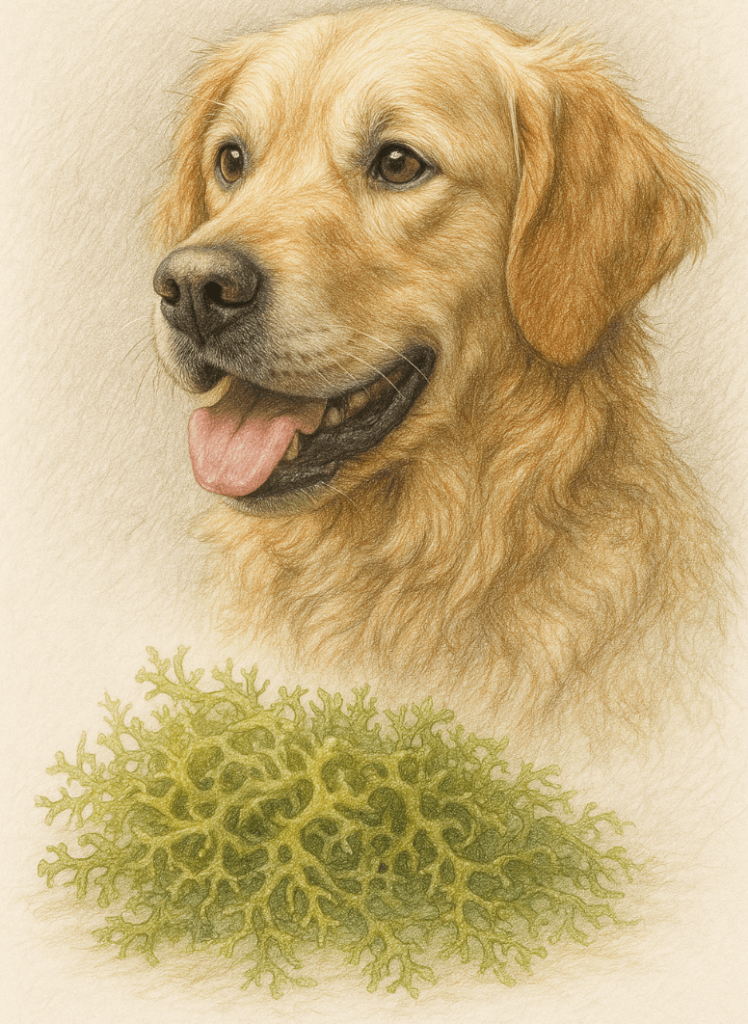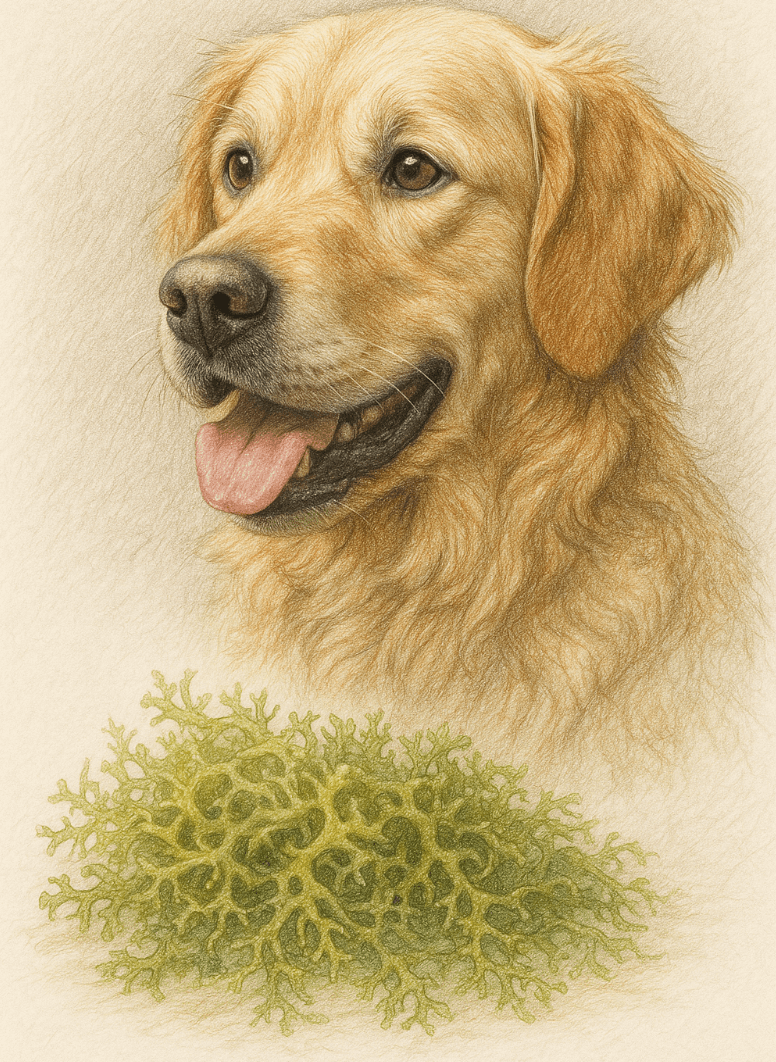Can Dogs Eat Sea Moss?
Sea moss, a nutrient-rich marine algae, has gained popularity in recent years for its health benefits in humans. But what about our furry friends? Many pet owners are curious whether sea moss is safe and beneficial for dogs. Packed with vitamins, minerals, and antioxidants, this superfood may seem like a great addition to your dog’s diet—but it’s essential to approach it with caution. In this blog post, we’ll explore whether dogs can safely consume sea moss, the potential benefits and risks, and how to introduce it responsibly. Whether you’re considering adding sea moss to your pup’s meals or simply want to learn more, this guide will provide all the information you need to make an informed decision.
Potential Benefits of Sea Moss for Dogs
When fed in moderation and prepared correctly, sea moss can offer several health benefits for dogs. Its rich nutrient profile makes it a promising supplement for supporting overall well-being.
Rich in Essential Nutrients:
Sea moss contains vitamins like A, C, E, and K, as well as minerals such as calcium, magnesium, and potassium, which support immune function and bone health.Supports Digestive Health:
The prebiotic properties of sea moss can promote a healthy gut by nourishing beneficial bacteria in the digestive tract.Anti-Inflammatory Properties:
Compounds in sea moss, such as carrageenan, may help reduce inflammation, benefiting dogs with joint issues or allergies.Boosts Coat and Skin Health:
The omega-3 fatty acids and minerals in sea moss can improve skin hydration and give your dog’s coat a shiny, healthy appearance.May Aid Weight Management:
Low in calories but high in fiber, sea moss can help dogs feel fuller longer, making it a useful addition for weight management plans.
While these benefits are promising, it’s crucial to consult your veterinarian before introducing sea moss to ensure it aligns with your dog’s specific needs.
Risks and Precautions When Feeding Sea Moss to Dogs
Although sea moss has potential benefits, it also comes with risks that every dog owner should be aware of. Understanding these concerns ensures your dog’s safety and well-being.
Risk of Allergic Reactions:
Some dogs may be allergic to sea moss or other marine plants, leading to symptoms like itching, swelling, or gastrointestinal upset.High Iodine Content:
Excessive iodine from overconsumption of sea moss can disrupt thyroid function, causing hormonal imbalances in dogs.Digestive Upset:
Too much sea moss can lead to diarrhea, vomiting, or bloating due to its high fiber content.Quality and Contamination Concerns:
Poor-quality sea moss may contain heavy metals or pollutants, posing serious health risks to your dog.Interactions with Medications:
Sea moss may interact with certain medications, particularly those affecting the thyroid or blood pressure. Always check with your vet first.
By being mindful of these risks, you can minimize potential harm and ensure a safe introduction of sea moss into your dog’s diet.
Check this guide 👉Can Dogs Eat Truffle Oil? Best 7 Expert Tips!
Check this guide 👉Can Dogs Eat Nachos? Best 7 Expert Tips!
Check this guide 👉Can Dogs Eat Gourds? Best 7 Expert Tips!

Benefits of Sea Moss for Dogs | Risks of Feeding Sea Moss to Dogs |
|---|---|
Supports immune system health | Risk of allergic reactions |
Promotes healthy digestion | High iodine levels can harm thyroid |
Improves skin and coat condition | Potential digestive upset |
Anti-inflammatory properties | Contamination risks from poor sourcing |
Helps with weight management | Possible medication interactions |
How to Safely Introduce Sea Moss to Your Dog’s Diet
If you decide to feed sea moss to your dog, it’s important to do so gradually and responsibly. Follow these guidelines to ensure a smooth introduction.
Choose High-Quality Sea Moss:
Opt for organic, wild-harvested sea moss free from contaminants or additives to ensure purity.Prepare It Properly:
Soak dried sea moss in water overnight, then blend it into a gel form for easier incorporation into meals.Start with Small Amounts:
Begin with a minimal dose (e.g., ¼ teaspoon per day for small dogs) and monitor your dog’s reaction closely.Mix with Food:
Add sea moss gel to your dog’s regular meals, blending it with wet food or mixing it into homemade treats.Consult Your Veterinarian:
Before introducing any new supplement, seek professional advice to confirm it’s appropriate for your dog’s age, size, and health status.
Taking these steps ensures a safe and gradual transition while minimizing the risk of adverse effects.
Signs Your Dog May Not Tolerate Sea Moss
Even with careful preparation, some dogs may not tolerate sea moss well. Watch for these warning signs to act quickly if something goes wrong.
Gastrointestinal Issues:
Symptoms like diarrhea, vomiting, or excessive gas may indicate digestive intolerance to sea moss.Skin Irritation or Itching:
Redness, rashes, or persistent scratching could signal an allergic reaction to the supplement.Lethargy or Behavioral Changes:
Sudden changes in energy levels or behavior might suggest an adverse reaction to sea moss.Swelling or Breathing Difficulties:
Severe allergic reactions can cause facial swelling or difficulty breathing—seek emergency veterinary care immediately.Thyroid Imbalance Signs:
Weight fluctuations, hair loss, or lethargy may point to thyroid issues caused by excessive iodine intake.
Recognizing these signs early allows you to address problems promptly and adjust your dog’s diet accordingly.
Common Mistakes to Avoid When Feeding Sea Moss
To ensure your dog’s safety and maximize the benefits of sea moss, avoid these common mistakes that could lead to complications.
Overfeeding Sea Moss:
Giving too much sea moss can overwhelm your dog’s system and cause digestive issues or nutrient imbalances.Skipping Veterinary Approval:
Bypassing professional advice increases the risk of introducing unsuitable supplements into your dog’s diet.Using Contaminated Products:
Low-quality sea moss may contain harmful substances, jeopardizing your dog’s health. Always choose trusted sources.Ignoring Allergy Testing:
Failing to test for allergies beforehand can result in unexpected reactions, putting your dog at unnecessary risk.Assuming It’s a Cure-All:
While beneficial, sea moss is not a substitute for proper veterinary care or a balanced diet tailored to your dog’s needs.
Avoiding these pitfalls ensures a safer and more effective experience when incorporating sea moss into your dog’s routine.
Alternatives to Sea Moss for Nutritional Support
If sea moss isn’t suitable for your dog or you’re hesitant to try it, there are plenty of alternatives that provide similar nutritional benefits without the associated risks.
Fish Oil Supplements:
Rich in omega-3 fatty acids, fish oil supports skin, coat, and joint health without the iodine concerns of sea moss.Pumpkin Puree:
High in fiber and nutrients, pumpkin aids digestion and helps regulate bowel movements naturally.Kelp Powder:
Another marine-based option, kelp offers trace minerals and vitamins but should also be used cautiously.Probiotics for Dogs:
These supplements promote gut health and strengthen the immune system, similar to sea moss’s prebiotic effects.Balanced Homemade Diets:
Incorporating lean proteins, vegetables, and whole grains provides comprehensive nutrition without relying on single supplements.
These alternatives allow you to cater to your dog’s needs while avoiding potential complications from sea moss.
Fun Ways to Incorporate Sea Moss Into Your Dog’s Diet
If you’ve decided to include sea moss in your dog’s meals, here are some creative and enjoyable ways to integrate it seamlessly.
Blend into Smoothies:
Combine sea moss gel with dog-safe fruits like blueberries or bananas for a tasty treat packed with nutrients.Add to Homemade Treat Recipes:
Mix sea moss gel into cookie dough or frozen yogurt bites for a fun and healthy snack.Incorporate into Wet Food:
Stir a small amount of sea moss gel into canned food for a subtle boost of nutrition.Freeze for Summer Treats:
Freeze sea moss gel in ice cube trays or molds for refreshing summer snacks your dog will love.Sprinkle Over Meals:
For picky eaters, mix dried sea moss powder sparingly into dry kibble for added flavor and nutrients.
These ideas make feeding sea moss enjoyable for both you and your dog, enhancing their diet creatively and safely.
Frequently Asked Questions About Dogs and Sea Moss
Can puppies eat sea moss?
It’s best to avoid giving sea moss to puppies unless specifically recommended by your veterinarian, as their digestive systems are still developing.
How much sea moss can I give my dog?
Start with very small amounts (e.g., ¼ teaspoon daily for small dogs) and adjust based on your vet’s guidance.
Is dried or fresh sea moss better for dogs?
Dried sea moss is easier to store and prepare, but always ensure it’s organic and free from contaminants.
Can sea moss replace my dog’s regular supplements?
No, sea moss should complement—not replace—a balanced diet and prescribed supplements. Consult your vet for personalized advice.
What should I do if my dog has a reaction?
Stop feeding sea moss immediately and contact your veterinarian for further evaluation and treatment.
Making an Informed Decision About Sea Moss for Your Dog
Feeding sea moss to your dog can be a rewarding way to enhance their diet, provided it’s done thoughtfully and under veterinary supervision. While its nutrient-dense profile offers numerous potential benefits, the risks associated with improper use cannot be ignored. By understanding your dog’s unique needs, sourcing high-quality products, and monitoring their response, you can determine whether sea moss is a suitable addition to their meals. Remember, your dog’s health and happiness depend on your diligence and care—so always prioritize their well-being above trends or fads.
Cat Fever Treatment: Best 7 Expert Tips! Discover expert advice on identifying, managing, and treating fever in cats to ensure their quick recovery and well-being.
Understanding Meloxicam for Cats: Best 7 Expert Tips! Learn how to safely administer meloxicam, manage side effects, and ensure your cat's comfort with expert advice on feline pain relief.
Amoxicillin for Cat UTI: Best 7 Expert Tips! Discover safe usage, dosage guidelines, and expert advice on treating feline urinary tract infections effectively with amoxicillin.
Understanding Cat Cancer Treatment: Best 7 Expert Tips! Discover expert advice on managing feline cancer, from early detection to treatment options, ensuring your cat’s health and comfort.





